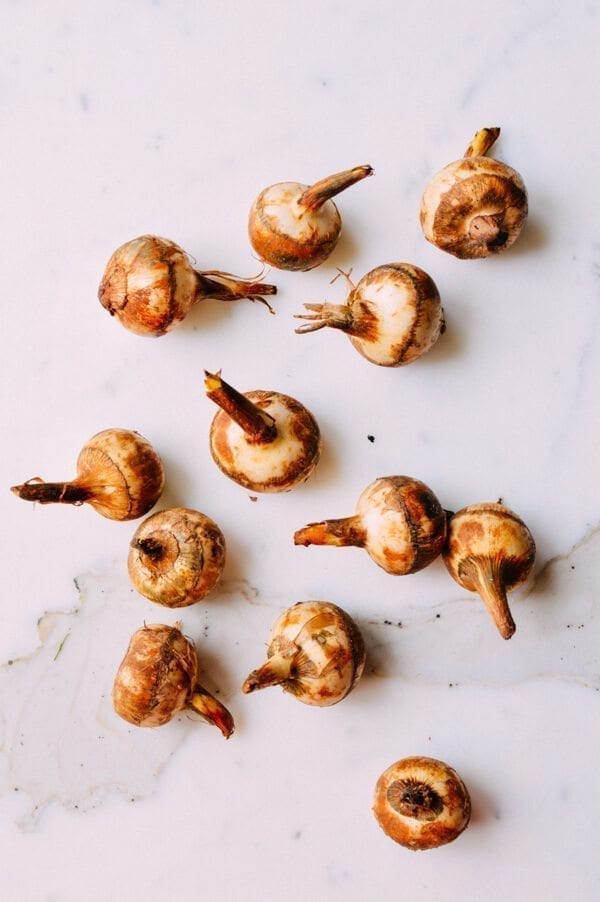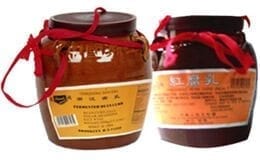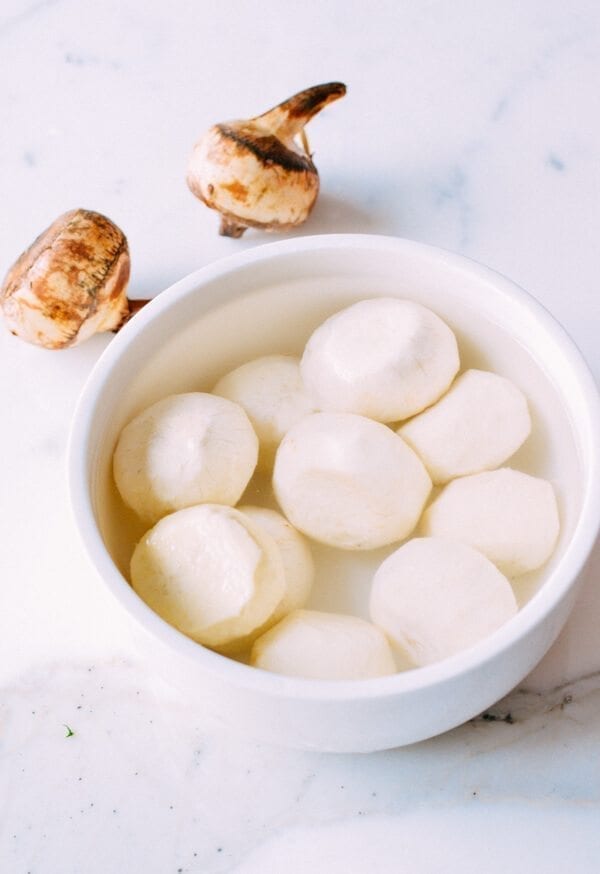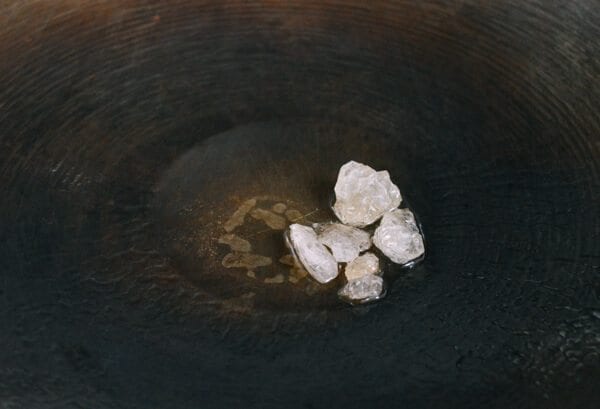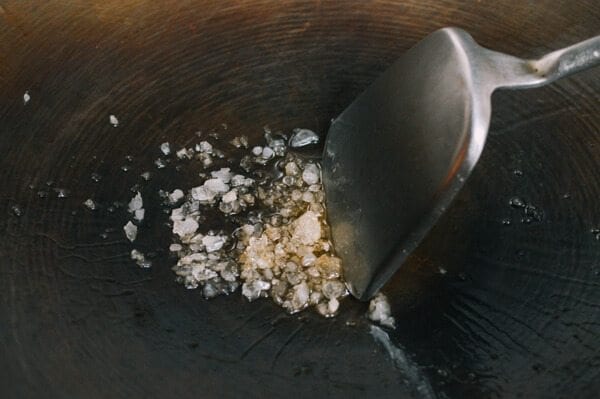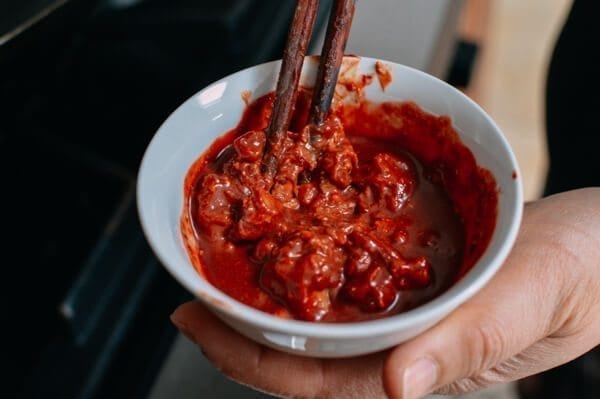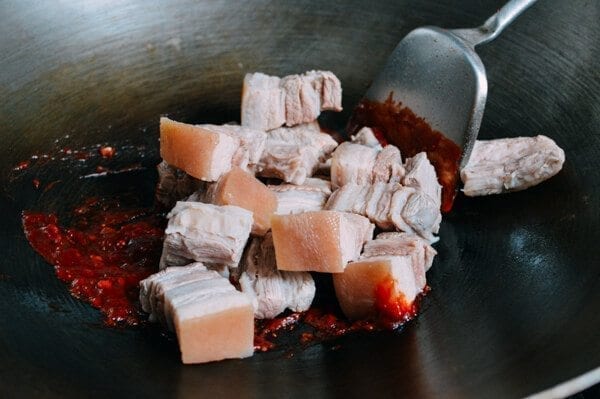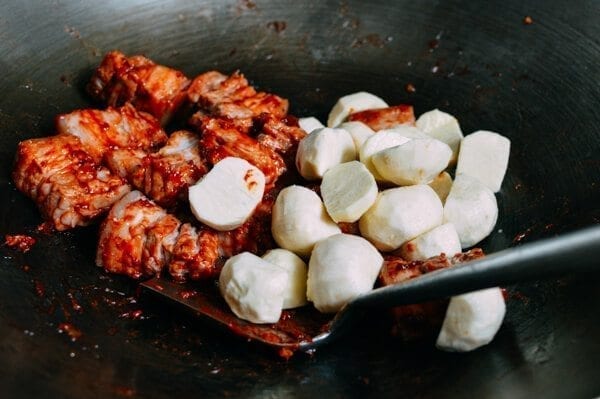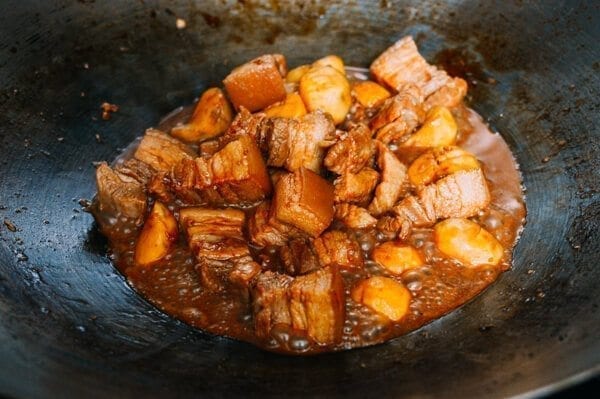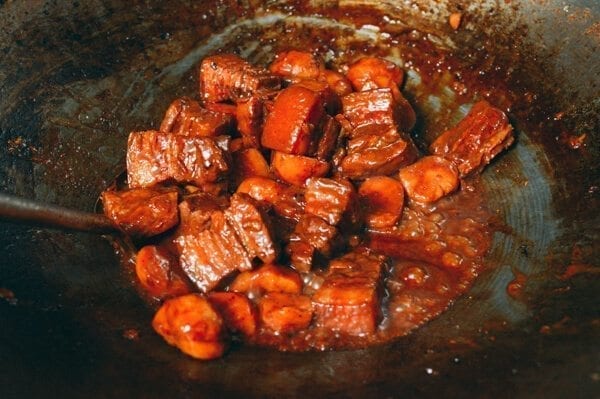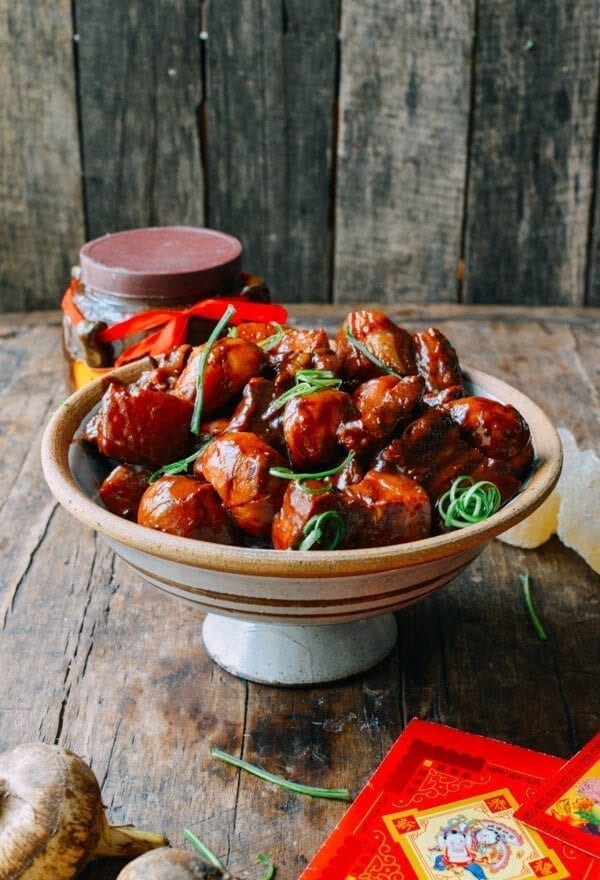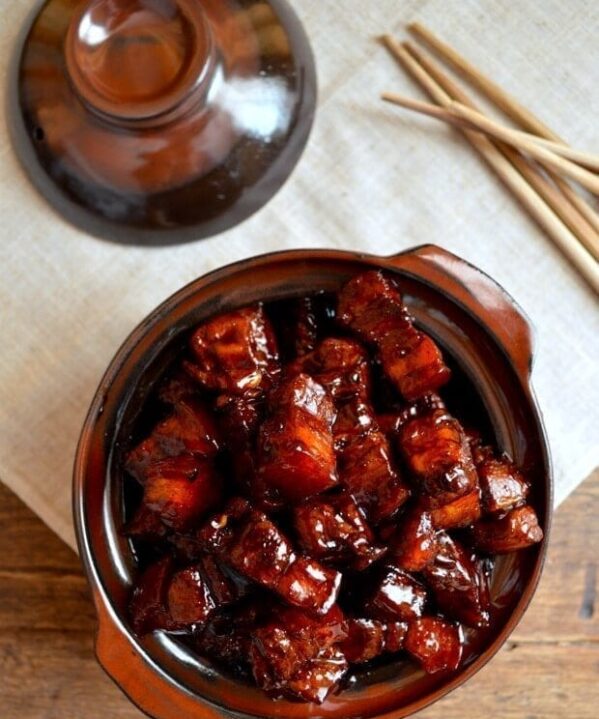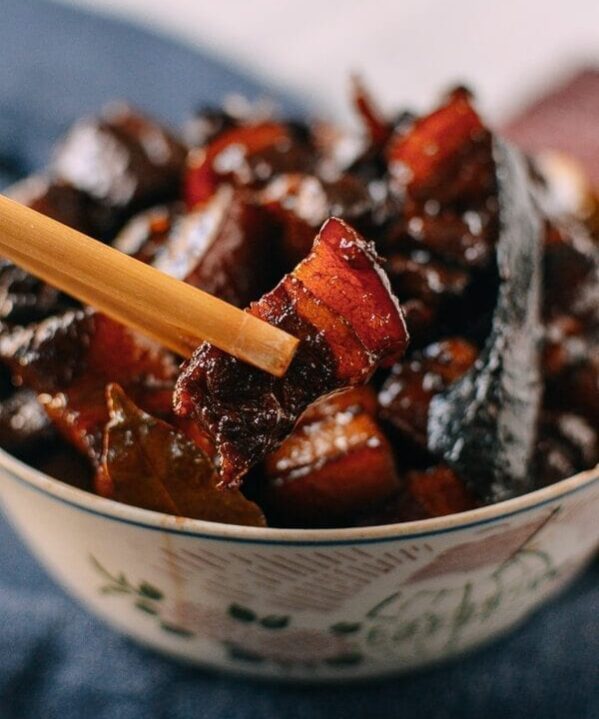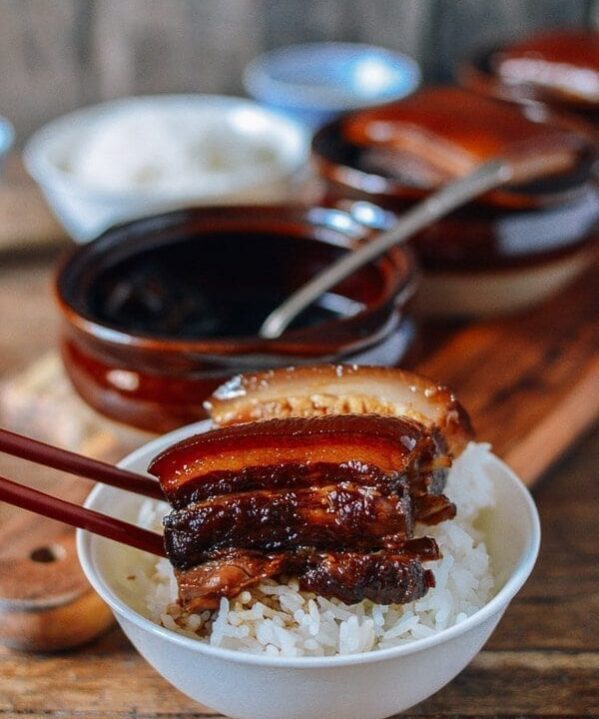As we mentioned in our Chinese New Year Menu post (2015), Braised Pork Belly with Arrowhead Root or cí gū mèn nan ròu in Mandarin 慈菇焖腩肉 (the dish’s name really rolls off the tongue, doesn’t it?) is a must-have dish in our house for Chinese New Year.
In Cantonese dialect, Bill’s family has always called it “see goo mun fay gee yook” which literally means “Arrowhead root braised with fat pork meat” which strikes a culinary cord with him every time Chinese New Year rolls around. All the more reason why we also have it in our Chinese New Year recipe list for 2016 and in our Chinese New Year Recipe Planner archive!
This Cantonese style braised pork belly is one of Bill’s absolute favorites or all pork belly recipes—it’s somewhat similar to our Red Cooked Pork recipe, but it gets an extra dimension of flavor from the addition of fermented bean curd (as is usually the case with these things, it tastes better than it sounds) and the unique flavor of the arrowhead root.
When we first got married, my mother-in-law would always ask me to eat arrowhead root during Chinese New Year. I had no idea why, until Bill told me the real reason, which is that according to Cantonese tradition, they’re supposed to “help” you have sons. Considering the fact that we ended up with two daughters, I’m not so sure how reliable that advice really was.
Okay, putting aside the bizarre story and my mother-in-law’s dashed hopes, this Cantonese style braised pork belly with Chinese arrowhead is just a great dish. Arrowhead is available now in Asian markets, and you better get there fast if you want to give them a try!
I’ve only seen them around the winter months. Any other time of year, I can’t find them—not even in cans. Their texture is almost like a cross between a potato and a water chestnut, and if you really can’t find them, you can substitute potatoes in this dish (especially if you’re not particular about wanting to bear sons).
Cantonese Style Braised Pork Belly with Arrowhead Root: Recipe Instructions
For the fermented bean curd, make sure you’re buying the RED kind, because there’s also one that’s white. You can read more about fermented bean curd in our ingredient post since we explain everything there is to know about the different types! We buy this brand in a clay pot:
You can also get this red bean curd in regular jars:
Cut pork belly into large (0.75” x 1.5”) chunks. Cutting them larger means they’ll take a little longer to cook, but it’s symbolic of wealth and prosperity for the new year. Bring a large pot of water to a simmer and blanch the meat just until it turns opaque. Drain, rinse, and set aside.
Peel the arrowhead roots. It’s almost like peeling an apple; just trim off the top and bottom, and peel the outer skin. Immediately drop each peeled root into a bowl of cold water to prevent oxidation. If using potatoes, you’re going to want to cut them into 1 1/2-inch chunks, but don’t cut them just yet (they take less time to cook than the arrowhead root).
When you’re ready to cook, take the roots out of the bowl of water and cut each in half.
Heat the oil in a wok over low heat and add the rock sugar.
Let it melt slowly and then add the red fermented bean curd/liquid. Stir for a minute.
Now add the blanched pork belly and arrowhead roots (if using potatoes, do not add them yet).
Turn the heat to medium and mix everything well. Add the shaoxing wine, dark soy sauce, and 2 cups of water. Stir everything together and cover the lid. Simmer over medium low heat.
Check the pot every 5-10 minutes; as the liquid evaporates, add more water 1 cup at a time, stir, and replace the lid. Continue doing that until the meat is fork-tender and the sauce is thickened enough to coat the pork. In my case, it took 5 cups of water, and about 1 hour and 15 minutes to fully cook the pork and arrowhead root. If using potatoes, cut them into chunks and stir them in after the pork has cooked for about 45 minutes.
If the braised pork belly is fork tender, but there’s still a lot of visible liquid, uncover the wok and turn up the heat to medium high. Stir constantly until the sauce is reduced to a gravy-like state. You can see how the sauce turned into a rich color after it has been stewed and the liquid has been reduced.
Serve with lots of rice and a vegetable, like stir-fried greens or broccoli.
It’s ready to serve on your Lunar New Year dinner table!
Now if these pictures don’t leave you wanting to make this Cantonese style braised pork belly recipe, then maybe a easy roast pork belly is what you need.
Cantonese Style Braised Pork Belly with Arrowhead Root
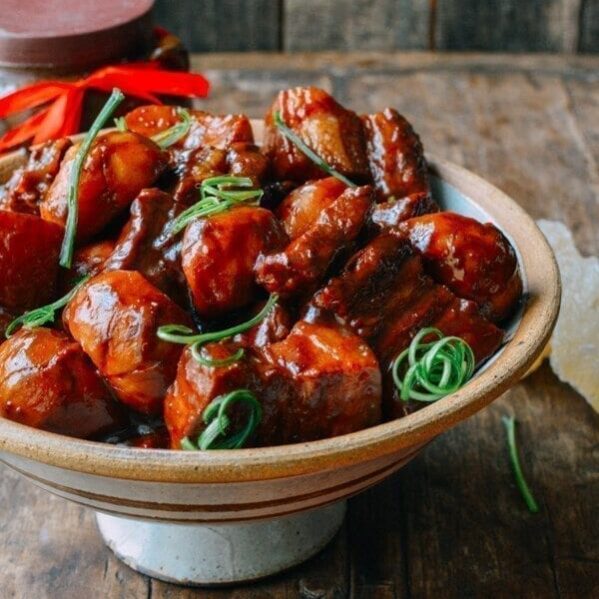
Ingredients
- 2 pounds pork belly (about 1 kg)
- 10 arrowhead roots (or 2 - 3 large potatoes)
- 2 tablespoons oil
- 2/3 oz. rock sugar (20g)
- 2 pieces red fermented bean curd (with 1 tablespoon of the liquid from the jar; you might see it labeled as “bean cheese")
- 1/4 cup shaoxing wine
- 1 ½ teaspoons dark soy sauce
- 5 cups water
Instructions
- Cut pork belly into large (0.75” x 1.5”) chunks. Bring a large pot of water to a simmer and blanch the meat just until it turns opaque. Drain, rinse, and set aside.
- Peel the arrowhead roots. Just trim off the top and bottom, and peel the outer skin. Immediately drop each peeled root into a bowl of cold water to prevent oxidation. If using potatoes, you're going to want to cut them into 1 1/2-inch chunks, but don't cut them just yet (they take less time to cook than the arrowhead).
- When you’re ready to cook, take the arrowhead roots out of the bowl of water and cut each in half. Heat the oil in a wok over low heat and add the rock sugar. Let it melt slowly and then add the fermented bean curd/liquid. Stir for a minute. Now add the blanched pork belly and arrowhead roots (if using potatoes, do not add them yet).
- Turn the heat to medium and mix everything well. Add the shaoxing wine, dark soy sauce, and 2 cups of water. Stir everything together and cover the lid. Simmer over medium low heat.
- Check the pot every 5-10 minutes. As the liquid evaporates, add more water 1 cup at a time and replace the lid. Continue doing that until the meat is fork-tender and the sauce is thickened enough to coat the pork. In my case, it took 5 cups of water, and about 1 hour and 15 minutes to fully cook the pork and arrowhead root. If using potatoes, cut them into chunks and stir them in after the pork has cooked for about 45 minutes.
- If the pork is fork tender, but there’s still a lot of visible liquid, uncover the wok and turn up the heat to medium high. Stir constantly until the sauce is reduced to a gravy-like state.

